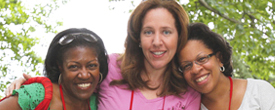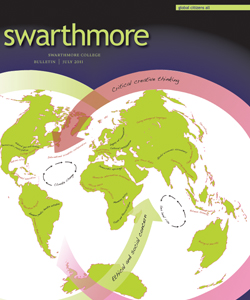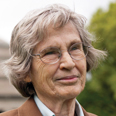Features
Global Citizens All
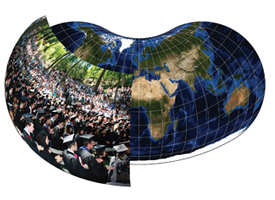 AN INTERVIEW WITH REBECCA CHOPP
AN INTERVIEW WITH REBECCA CHOPPWhy does the world need “global citizens?” What changes have occurred that require a different kind of worldview?
“Global citizen” is a vague term and, like all such terms, a contested concept—but it points toward the reality that the modern world is interconnected. We can communicate with people all over the world in real time. The flow of capital; the exchange of goods, services, and information; and the migration patterns of many populations make us aware of these interconnections. As stewards and citizens of the world, we are also linked by environmental and political challenges that require us to work together to create a sustainable and just world. We need to understand our location within these complex new realities.
Features
Style and Substance
By Elizabeth Redden ’05
 “GLAMOUR'S ROLE IS TO MAKE READERS FEEL GREAT ABOUT THEIR LIVES and to give them, in every issue, a balance of fun and fashion and compassion and support,” says Cindi Leive ’88, editor-in-chief of the magazine, which boasts a readership of 12 million and outsells 98 percent of magazines on the newsstand. “My editorial vision is that it’s completely possible for a magazine to embrace—wholeheartedly embrace—fashion and beauty, and at the same time tackle serious issues of substance.”
“GLAMOUR'S ROLE IS TO MAKE READERS FEEL GREAT ABOUT THEIR LIVES and to give them, in every issue, a balance of fun and fashion and compassion and support,” says Cindi Leive ’88, editor-in-chief of the magazine, which boasts a readership of 12 million and outsells 98 percent of magazines on the newsstand. “My editorial vision is that it’s completely possible for a magazine to embrace—wholeheartedly embrace—fashion and beauty, and at the same time tackle serious issues of substance.”“I have plenty of smart female friends who can get into a heated discussion about whether platform shoes are a good or bad thing for the world and also talk about child brides in Yemen. There’s no reason those two things can’t cohabitate.”
Features
Chernobyl Witness
 BY THE TIME I GRADUATED FROM SWARTHMORE IN 1994, I HAD BURNED OUT AS AN ACTIVIST. I’d spent years telling people, stridently, what was wrong with the world, trying to change their ways. I rarely succeeded.
BY THE TIME I GRADUATED FROM SWARTHMORE IN 1994, I HAD BURNED OUT AS AN ACTIVIST. I’d spent years telling people, stridently, what was wrong with the world, trying to change their ways. I rarely succeeded.The next year, I left for India. I spent seven months volunteering and wandering, camera in hand. I loved photography but was not yet a photographer. In India, I first discovered that taking photos helps me see better. Slowing down enough to take photographs is a practice, like meditation, that helps us become more aware of what is right there in front of our eyes—or inside our minds.
Related Article
Features
Juvenile Injustice
By Susan Cousins Breen
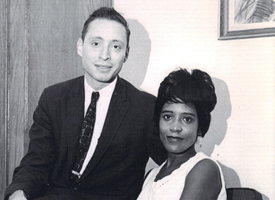 IT WAS 1996 WHEN CIVIL RIGHTS CRUSADER AND ATTORNEY EDGAR CAHN convinced District of Columbia Supreme Court Judge Eugene Hamilton to approve new juvenile justice courts in the city. Describing the district’s juvenile justice system as “a direct pipeline feeding youth into the adult prison system,” Cahn presented the court with the following statistics—numbers that told a disturbing truth about juvenile justice throughout the United States:
IT WAS 1996 WHEN CIVIL RIGHTS CRUSADER AND ATTORNEY EDGAR CAHN convinced District of Columbia Supreme Court Judge Eugene Hamilton to approve new juvenile justice courts in the city. Describing the district’s juvenile justice system as “a direct pipeline feeding youth into the adult prison system,” Cahn presented the court with the following statistics—numbers that told a disturbing truth about juvenile justice throughout the United States: Collection
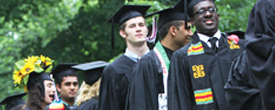
- Away They Go!
- Pictures from an Institution
- Lott to Step Down as Editor
- Turnin' Pro
- A Matter of Degrees
More collection articles from this issue
Books + Arts
A Forgotten Film About an Unforgettable Trial
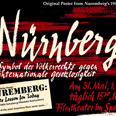 In October 1945, in the ruins of Nuremberg, Germany, the victorious Allied nations convened the first in a series of groundbreaking legal proceedings. The trials marked a milestone for international law, setting a precedent for international criminal prosecution that we struggle to live up to even today.
In October 1945, in the ruins of Nuremberg, Germany, the victorious Allied nations convened the first in a series of groundbreaking legal proceedings. The trials marked a milestone for international law, setting a precedent for international criminal prosecution that we struggle to live up to even today.
In My Life
Caring for Mom
By Thompson Webb III ’66
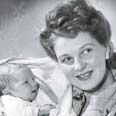 Not long after my mother died in 2009, I realized that I had accomplished one of my life’s dreams by caring for Mom during her final decade. It was not a dream that I could have articulated when at Swarthmore, but it was a dream that emerged once my parents began aging and especially when Mom would comment while weary with all her care for Dad, “Who is going to care for me?” I had no answer, but I knew that we would find a way.
Not long after my mother died in 2009, I realized that I had accomplished one of my life’s dreams by caring for Mom during her final decade. It was not a dream that I could have articulated when at Swarthmore, but it was a dream that emerged once my parents began aging and especially when Mom would comment while weary with all her care for Dad, “Who is going to care for me?” I had no answer, but I knew that we would find a way.
Q + A
More Teams to Coach, More Fun to Have
By Robert Strauss
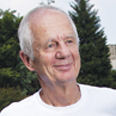 Mike Mullan’s office is, to put it kindly, a bit of a mess. The one presumed “guest” chair has a half-case of bottled water barely hugging its seat. A desk is filled with tennis balls, balancing as they can, with various bandages and wraps intertwined. There are old Swarthmore pennants and well-worn books and tennis gear here and there. The walls have a framed diploma from Temple University, slightly askew, and a similarly tilted clipping from a far-off romance-language newspaper.
Mike Mullan’s office is, to put it kindly, a bit of a mess. The one presumed “guest” chair has a half-case of bottled water barely hugging its seat. A desk is filled with tennis balls, balancing as they can, with various bandages and wraps intertwined. There are old Swarthmore pennants and well-worn books and tennis gear here and there. The walls have a framed diploma from Temple University, slightly askew, and a similarly tilted clipping from a far-off romance-language newspaper.
